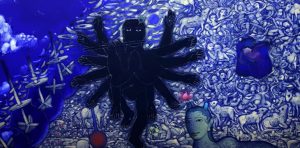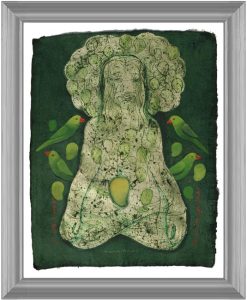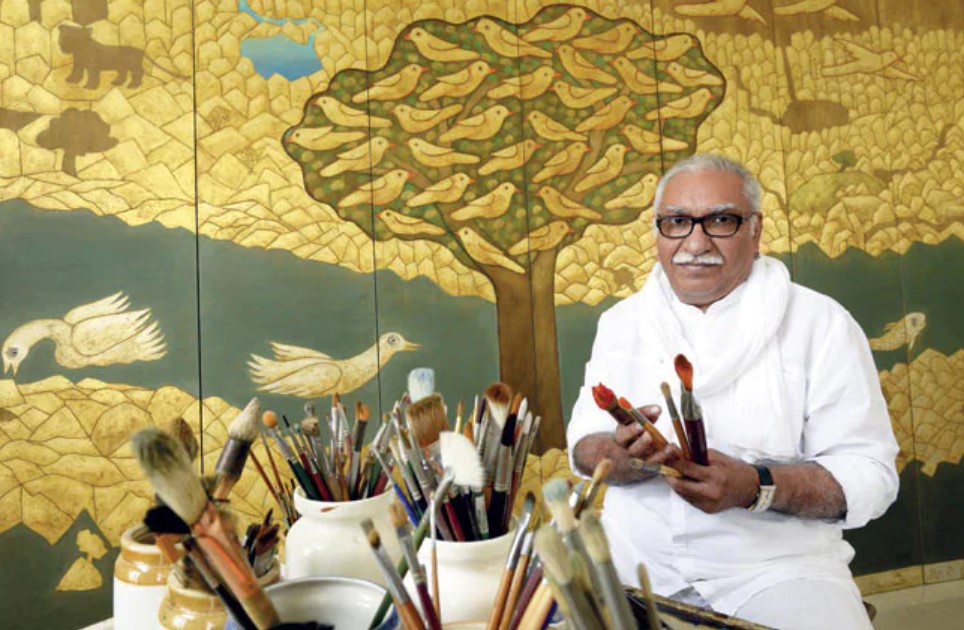Prachi Sahasrabudhe
Sidharth is a well-known artist who met and invited art critic, writer, and curator Johnny ML to his studio in Sukhdev Vihar, New Delhi, in July 2011. Johny ML was captivated by Sidharth’s stories and desired to tell them in his own voice. Johnny ML opted to frame the ‘speaker’ in the narrative as if it belonged to the artist as a narrator, whereas the narrator chose to frame the ‘speaker’ as if it belonged to the writer. As a result, Johny ML published 10 articles on his blog titled “By all means necessary.”
The book – ‘The Circle of Light’ is a collection of ten articles by Johny ML. Johnny ML acknowledges that he was consumed by Sidharth’s skill of storytelling when writing about him. Sidharth, on the other hand, relived his childhood days through words, bringing tears to the author’s eyes. The endeavour had been a frenetic period of concept and experience exchange between Sidharth as a storyteller and Johny ML as a listener. Sidharth even said that doing soliloquies was tough since one cannot speak to oneself for an extended period. Any narrative is a mutual narrative created by the speaker and the listener, just as a painting is completed when the artist engages in a conversation.
Through the act of perceiving, the viewer enters a zone of engagement with Sidharth. This act of reciprocal transference of selves allows a tale to be communicated, nurtured, elaborated, and comprehended. Some viewers, however, were sceptical of the artist’s magical life and art, finding it difficult to believe that an artist could be so magical in both his life and art. Their rational and sceptical brains always raised the question while viewing Sidharth’s art. The art world’s golden time mirrored certain artists’ shallow and unscrupulous aspects, such as those in politics, real estate, or movies. Sidharth was a respected artist who stands out from the crowd. People were curious about him and expressed their scepticism. Sidharth, on the other hand, was attracted by those who have nothing to do with their career or life, such as those who climb trees, drive taxis, work in call centres, and so on.
Sidharth tells a story of a young guy who was a great seeker of knowledge and lived on the field plains with his Guru. The young guy requested a better instructor from his Guru and was directed to the top of the hill to see the third Guru. After a few months, the guy approached the Guru for an even better instructor and was advised to travel to the plains to see a Guru who lives there. He descended the hills and arrived at the Ashram, where the all-knowing Guru was residing. He was astounded to see his own reflection there. The young guy realised that expressing the difference through someone or something is an incarnation of their own. Similarly, for Sidharth, the instrument he played was not just an instrument, but his own extended self-seen in the form of an instrument.

The book ‘Circle of Light’ is a collection of articles on Sidharth that bring his life and work to life in new ways. Johny ML had never gone to Punjab, Chandigarh, Sweden, or Dharamsala as a writer, but when he wrote about them, it was the writer, not Sidharth, who was travelling through them. Andretta with Shobha Singh, Dorji at a monastery, and St. Birgitta Church in Sweden were all places where the writer sensed, touched, and smelled everything. The writer was telling a narrative through Sidharth in the same manner as Sidharth was telling a story through him.
Sidharth was visiting Japan with his family and a few Indian artists when they arrived at Hakune, a secluded town with a river on one side and a forested mountain on the other. Sidharth sat on the beach, staring at a man who had been sitting still on a boat for a long time. After about an hour, the man moved and approached Sidharth on the beach. Sidharth and his family boarded the boat, which brought them to the other shore. They tracked out a man who was older than old age itself and inquired about Sidharth’s life. The old guy chuckled when Sidharth informed him he was an artist. Sidharth and the boatman exited the area and the old man said he would never come back to him. Sidharth did not accompany the artist’s friends to Hiroshima the following day. Instead, he walked down to the riverbank and waited for someone. By noon, a boatman arrived and took Sidharth to the old man’s ashram. The old man grinned and explained to Sidharth that all substances had life and could be influenced by higher energies. Sidharth spent time with the old guy and felt transported to another planet and era. By the evening, the boatman had returned Sidharth to the opposite strand, but he felt rejuvenated.
Sidharth is an artist who thinks that every material has a life of its own and that it can be tamed with love and respect. He is as enthusiastic about the works of emerging artists as he is about the works of both contemporary and old masters. He is also interested in new technology, owning a collection of cameras and gadgets, editing software, and computer music composition. However, he believes that not all of these technologies should be used in his paintings or works. Sidharth creates his visual
autobiography without ever using his own image. He talks via other individuals and thinks that only through oneness can a world be whole. He believes that art and culture can save the planet and that technology should not be exploited as a substitute.

Sidharth contends that when we are creative, we become one with nature and everything that it contains. He proposes that we cultivate human attributes rather than superhuman ones, and aim for a non-dual world free of polemics. Sidharth thinks that art and technology may assist us in achieving this goal and that one day we shall live in a society where one exists for all and all exist for one.
***
References:
- ML, Johnny, “The circle of Light – Life and times of Siddharth,” Chennai, Prakrit Arts Pvt.ltd., p.p. 72 to 78.
• ML, Johnny, ‘By all means necessary,’ July 2011, JohnyML. blogspot.com. • https://www.gallerienvya.com/artist/sidharth/





